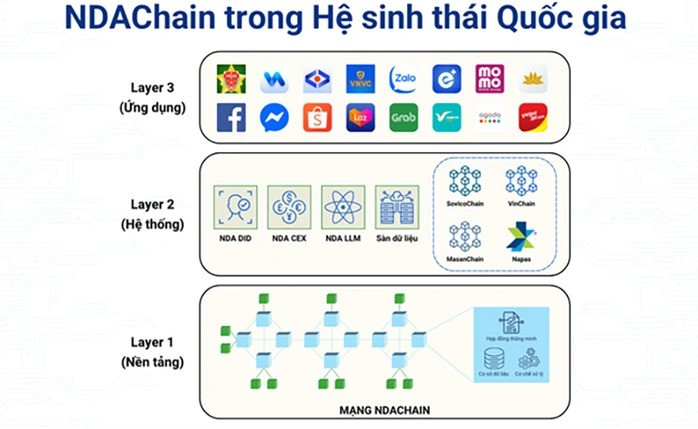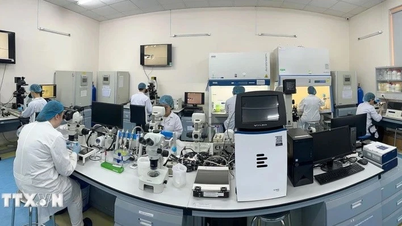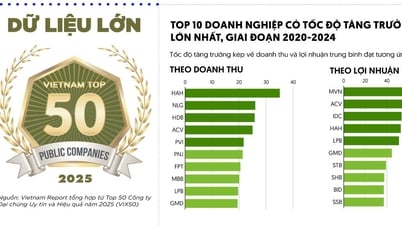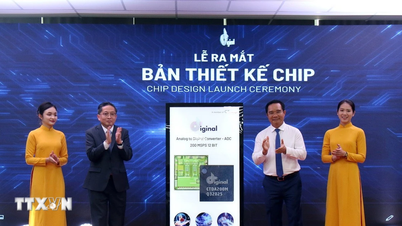NDAChain has been researched since late 2024 and officially announced in June 2025. This is a key technology project chaired by the National Data Center (under the Ministry of Public Security ), under the direction and support of the National Data Association - a newly established organization with the mission of building and mastering core technologies to serve the development of digital infrastructure.

Unlike public blockchains like Ethereum or Bitcoin, NDAChain operates on a permissioned blockchain model. This means that only a group of validating nodes – currently consisting of 49 members who are large domestic technology enterprises – are allowed to participate in confirming and recording transactions. This model not only helps improve governance efficiency but also meets the requirements for strict control in areas related to citizen data, digital records or public service information.
According to the development team, under simulated conditions with five validator nodes and a simulated latency of 50 ms, NDAChain achieved an average speed of 1,200 transactions per second, with a confirmation latency of about 1.5 seconds. When optimized, the system can handle up to 3,600 transactions/second – a number approaching high-speed blockchain platforms operating internationally.

NDAChain uses the Proof-of-Authority (PoA) consensus algorithm, a mechanism that enables fast, stable, and low-energy authentication. At the same time, the platform integrates Zero-Knowledge Proof (ZKP) security technology, allowing data verification without revealing the original content - a solution that is especially necessary in systems related to sensitive information and personal privacy.
Not only stopping at speed and reliability, NDAChain is also built according to international standards such as W3C DID (decentralized identifier), Verifiable Credentials and GDPR, facilitating integration into cross-border systems, in line with the future orientation of international expansion and interconnectivity.
NDAChain is designed to act as a smart middleware layer, authenticating, recording, and encrypting data before it is transferred to central processing centers. This reduces the load on central databases while increasing traceability, monitoring, and transparency of information at all levels.
The potential applications of NDAChain are considered very broad. In the manufacturing and logistics sectors, the platform can support the tracking of goods, authentication of shipping documents and supply chain management. For the pharmaceutical and food industries, NDAChain acts as an anti-counterfeiting tool, tracing the origin of products from factory to consumer.
In areas such aseducation , insurance or finance, NDAChain can be used to securely authenticate records, contracts and customer identities without relying on a third party. This helps shorten processing times, reduce fraud and create a foundation for trustworthy electronic transactions.
Along with NDAChain, the National Data Association is also developing the NDA DID decentralized identification system. With this model, individuals or organizations will have full control over their identification information, instead of depending on an intermediary management unit. This is considered a necessary step to overcome the inherent limitations of the centralized data model such as lack of security, difficulty in interconnection and lack of flexibility when deployed on a large scale.
According to the plan, NDAChain will be integrated into the National Data Center in 2025. In the next phase, from 2026, the platform will be expanded to apply in localities, universities and domestic technology enterprises. The long-term orientation is to develop extended layers (Layer 2), build a multi-industry application ecosystem and promote international cooperation in the field of digital data.
Not just an independent technology platform, NDAChain is also a core piece in the process of forming a national data ecosystem - where state agencies, businesses, organizations and individuals can interact, share and authenticate digital information in a unified, secure and controlled manner.
This ecosystem includes: the NDAChain blockchain platform, the NDA DID decentralized identification system, and the National Data Center – which operates, coordinates, and stores core data. This structure allows each data transaction to be tracked from the point of origin to the final processing point, with clear authentication, security, and traceability.

In the future, the national data ecosystem is expected to be a common platform for many digital applications, from online public services, administrative digitization, open education systems, digital payments to tools to support business management and the local digital economy. When fully deployed, it will help Vietnam reduce its dependence on foreign technology infrastructure, while increasing its proactiveness in controlling data, protecting personal information and ensuring digital sovereignty .
The birth of NDAChain shows that Vietnam is gradually approaching and mastering key infrastructure technologies, not only serving national governance but also paving the way for domestic enterprises to deploy high-value digital services.
Source: https://khoahocdoisong.vn/ndachain-nen-tang-blockchain-doc-quyen-cua-viet-nam-post1551481.html



























































































Comment (0)